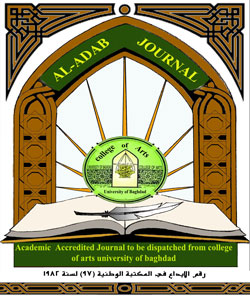Cultural history of the United Arab Emirates
DOI:
https://doi.org/10.31973/aj.v0i112.1464Keywords:
/Abstract
This article is a study of Culture and its impact in the Society. It is Important to Understand the Structure of Social powers and people and Economic Structure. This Research Consist of three Chapters, the First about Economic Situation in the Emirates of the Coast Oman, and Second Chapter deals with Social Structure, and third Chapter concerns with the Culture ,police,education,cultural Communities , media and press, the woman Culture work, Population culture,arts,and cultural movements.
Downloads
References
2. هزاع احمد سالم المنصوري، السياسة الخارجية في دولة الامارات العربية المتحدة 1971.. 2011، (ابوظبي: مركز سلطان بن زايد، 2011)، 28.
3. Alexis Normand, Les Emirats Du Golf,Au Defi Delurerture,(Paris; harm& Then, 2011), pp.43-44; ؛محمود علي الداود واَخرون، التجارب الوحدوية العربية المعاصرة: تجربة دولة الامارات العربية المتحدة، بحوث ومناقشاتها الندوة الفكرية، ط 4، (بيروت: مركز دراسات الوحدة العربية، 1999).
4. عبد الخالق عبدالله، زايد الأب المؤسس، في: كتاب في حب زايد، ط1، (الشارقة: دار الخليج وللصحافة والطباعة والنشر، 2004)، ص24-26.
5. ج.ج. لوريمر، وليل الخليج: القسم التاريخي، ترجمة مكتب الترجمة بديوان حاكم قطر، ج7، (الدوحة: قطر، مطابع العروبة، ،. 1967)، ص 3189، 3203. See: Mohamed G. AL- Rumaihi, Factors of Social and Economic: Development in the Gulf in the Eighties, in: klaus Jurgen GantzeL and Helmut Mejcher, (eds) Oil, the Middle East, North Africa and the Industrial States: Developmental and International Dimensions, International Gegen- wark, Bd,padreborn: f. Schningh, 1984), pp.208-210.
6. OPEC Statistical Bulletin (1971) and Neue Zeit, No.15 (1981)
7. اسامة عبد الرحمن، البيروقراطية النفطية ومعضلة التنمية: مدخل الى دراسة ادارة التنمية في اقطار الجزيرة العربية المنتجة للنفط سلسلة عالم المعرفة (57)، (الكويت: المجلس الوطني للثقافة والآداب، 1982)، ص 111-112؛ محمد رشيد الفيل، التكامل الاجتماعي والسياسة السكانية الموحدة الدول الخليج العربي، (الكويت: منشورات جامعة الكويت، 1987)،ص 303-300
Downloads
Published
Issue
Section
License
Copyright and Licensing:
For all articles published in Al-Adab journal, copyright is retained by the authors. Articles are licensed under an open access Creative Commons CC BY 4.0 license, meaning that anyone may download and read the paper for free. In addition, the article may be reused and quoted provided that the original published version is cited. These conditions allow for maximum use and exposure of the work.
Reproducing Published Material from other Publishers: It is absolutely essential that authors obtain permission to reproduce any published material (figures, schemes, tables or any extract of a text) which does not fall into the public domain, or for which they do not hold the copyright. Permission should be requested by the authors from the copyrightholder (usually the Publisher, please refer to the imprint of the individual publications to identify the copyrightholder).
Permission is required for: Your own works published by other Publishers and for which you did not retain copyright.
Substantial extracts from anyones' works or a series of works.
Use of Tables, Graphs, Charts, Schemes and Artworks if they are unaltered or slightly modified.
Photographs for which you do not hold copyright.
Permission is not required for: Reconstruction of your own table with data already published elsewhere. Please notice that in this case you must cite the source of the data in the form of either "Data from..." or "Adapted from...".
Reasonably short quotes are considered fair use and therefore do not require permission.
Graphs, Charts, Schemes and Artworks that are completely redrawn by the authors and significantly changed beyond recognition do not require permission.
Obtaining Permission
In order to avoid unnecessary delays in the publication process, you should start obtaining permissions as early as possible. If in any doubt about the copyright, apply for permission. Al-Adab Journal cannot publish material from other publications without permission.
The copyright holder may give you instructions on the form of acknowledgement to be followed; otherwise follow the style: "Reproduced with permission from [author], [book/journal title]; published by [publisher], [year].' at the end of the caption of the Table, Figure or Scheme.












